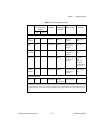
Chapter 3 Hardware Overview
© National Instruments Corporation 3-5 DIO 6533 User Manual
Strobed I/O—Pattern Generation and Handshaking
The 6533 devices can also perform strobed I/O. Strobed I/O is data
transfer in which the 6533 hardware regulates timing or performs
handshaking functions. The 6533 devices have two handshaking
controllers and can perform up to two strobed operations
simultaneously. The operations can be input transfers, output transfers,
or one of each.
You select the width of each transfer by allocating the digital I/O ports
into two groups for the two controllers. For example, by allocating
ports A and B to group 1, you can perform a 16-bit strobed transfer
using the group 1 controller. Any port that you do not allocate to a
group, you can use for unstrobed I/O.
LabVIEW users should note that the LabVIEW documentation uses the
term group in another context. LabVIEW groups do not correspond
directly to hardware groups.
Each hardware group has its own, independent set of timing control
lines—ACK (STARTTRIG), REQ, PCLK, and STOPTRIG—to carry
control, status, clocking, and trigger information.
Any external device that the 6533 devices control, monitor, test, or
communicate with is referred to as a peripheral device.
Strobed operations fall into two categories—pattern generation and
full, or two-way, handshaking transfer.
In pattern generation, data acquisition applications typically require
sampling input data at a predetermined frequency. Similarly,
waveform-generation applications require driving output data to
specific output patterns at a predetermined frequency. You can regulate
the frequency by supplying a timing signal to the REQ line; this signal
is an external request. The 6533 devices can also generate their own
REQ pulses, or internal requests. Each group has a 32-bit counter to
regulate the period between transfers.
In pattern generation, you can also supply start and stop triggers to
begin and end an operation. You can select either a rising edge or a
falling edge as a trigger signal. You can also trigger when the
6533 device detects a specified digital pattern on its data lines.


















